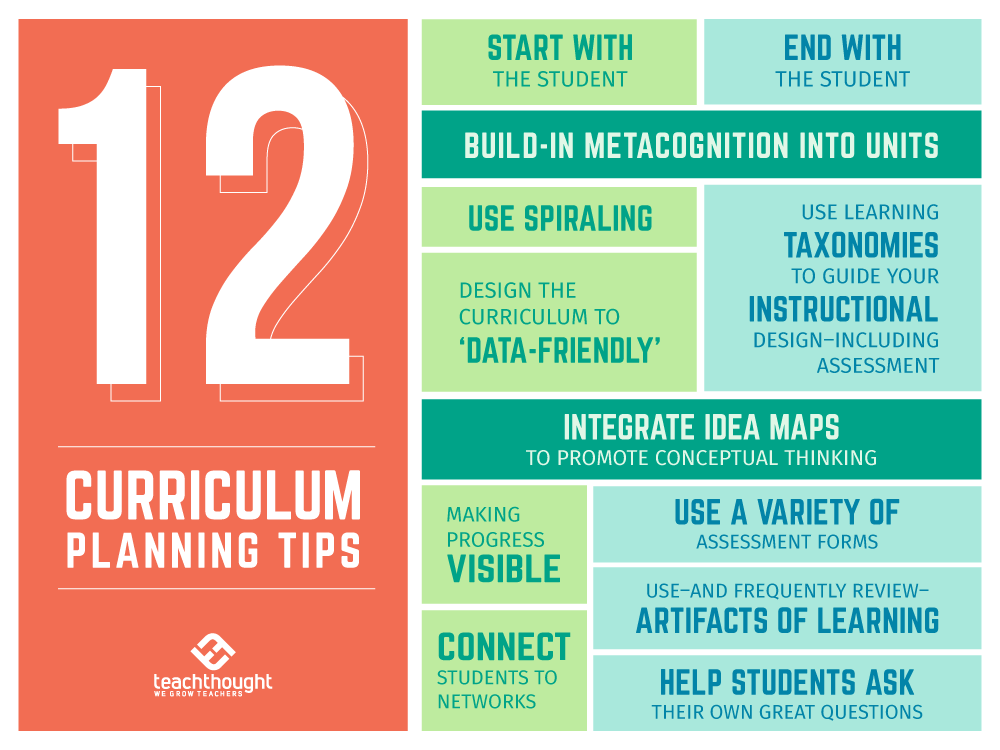
12 Curriculum Planning Tips For Any Grade Level Or Content Area
by Terry Heick
Learning is really just a growth in awareness.
From not knowing to knowing is part of it, but that’s really too simple because it misses all the degrees of knowing and not knowing. One can’t ever really truly understand something any more than a shrub can stay trimmed. There’s always growth or decay, changing contexts or conditions.
Understanding is the same way: it’s fluid.
Yes, this sounds silly and esoteric, but think about it. While morsels of information–math theorems, for example–may not change, the context students use them in do. Which in turn changes how we consider and use that morsel.
In fact, so little of the learning process is unchanging. Even facts–significant historical dates, labels for ethnic groups, causes and effects of cultural movements–all change endlessly, if not in form (how they’re discussed) than in meaning and connotation (what we think of them).
Design. Engineering. Religion. Media. Literacy. Human Rights. Geography. Technology. Science. All of these have changed both in form and connotation in the last decade, with changes in one (e.g., technology) changing how we think of another (e.g., design). And so how students use this skill or understanding.
And further how we, as teachers, ‘teach it.’
Making Learning A Process That Honors Change
The implications of awareness reach even further than that, however.
It’s more than merely ‘understanding’ or not, and grasping changing contexts for that understanding. It’s also about becoming more aware of one’s own degrees of not and not knowing.
This could be thought of as ‘depth of understanding,’ a term that produced a DOK framework for measuring understanding that’s still used in many districts. Bloom’s Taxonomy or even the TeachThought Learning Taxonomy are all tools to help evaluate understanding–how well a student ‘gets it.’
See also 10 Team-Building Games That Promote Critical Thinking
But learning is as much about knowing what you don’t know as it is proving what you do. An assessment can offer a guess how much–and how deeply–a student understands, but that’s all that it is–a guess based on a given assessment form, taken as a quick snapshot of student understanding at any given moment, marred by reading level, academic vocabulary, student self-efficacy, the wording of the question, or even their mood that morning.
So, takeaways for busy teachers in public schools for whom the above sounds like a bunch of time-wasting, pie-in-the-sky malarky?
12 Curriculum Planning Tips For Any Grade Level Or Content Area
1. Start with the student
Learning should start with the student–their personalized learning needs, their ‘place,’ and their self-initiated application of knowledge on a daily basis. This includes what they’re curious about, what builds on their strengths, and what agitates their thinking and forces them to reconsider what they think they know.
Who has time for that? Have them do the leg work and shift to a facilitator’s role.
2. End with the student
As stated above, learning starts and ends with people and emotions, not standards and data. Somehow, some way, everything a student learns should start and end with them–their misconceptions, affections, ideas, creativity, or reflections.
3. Build-in metacognition into units
Speaking of reflection, prime the pump with quick writing prompts about their own thinking. Model what metacognition looks/sounds/feels like. Have students share their thinking. Allow them to express themselves and their thinking away from the pressure of the classroom and the burden of eloquent verbal expression.
Add it to rubrics.
4. Use spiraling
In short, spiraling is the practice of designing curriculum which requires students to revisit content over and over again throughout their education career. This can mean their entire K-12 career, but also their freshmen year of high school, or even a single unit in a single content area.
Though the research proving its effectiveness is scant, the same could be said for mobile learning, critical thinking, inquiry, and other even-though-we-lack-a-strong-research-basis-it’s-clear-students-benefit-from-this instructional practices. By exposing students to critical content over and over again in increasingly complex ways, spiraling is a flexible and potent curriculum mapping strategy useful to educators in a range of applications, from curriculum and instructional design to test-prep or planning for project-based learning.
5. Use learning taxonomies to guide your instructional design–including assessment
Use learning taxonomies–and not just one–to illuminate understanding more clearly. Move way past ‘pass or ‘fail,’ or even A-F, to “Can define and apply, but has trouble analyzing.”
6. Integrate idea maps to promote conceptual thinking
Use idea maps–or concept maps, as we usually refer to them–in lessons early and often. Assessments, journal entries, scaffolding, lesson extensions, write-arounds, bell-ringers, and more. Have students map, chart, diagram, or otherwise visually represent their own learning pathways, and changes in their own understanding. What they do and don’t understand. Where they started, where they are, and where they might be going.
Have students map, chart, diagram, or otherwise visually represent their own learning pathways, and changes in their own understanding. What they do and don’t understand. Where they started, where they are, and where they might be going.
Concept maps show the relationship between ideas–how disparate ‘things’ fit together. Knowledge is about connections and interdependence, and concept maps and related graphic organizers are excellent ways to demonstrate that. Really want to push their thinking? Have students create their own concept maps before, during, and after a unit–or just once as a kind of assessment.
7. Design the curriculum to be ‘data-friendly’
Design data-friendly curriculum–that is, curriculum designed to’usefully absorb’ data. Such a curriculum would fail to function without data at key points that require the teacher to revise planned curriculum and instruction based on that data. That is, have a plan for the data before you give the assessment.
8. Making progress visible
Use gamification, XP, unlocking, colorful bar graphs, leveling, or some other way to says to the student, “you started there, and you’ve made it all the way to here.”
Of course, making learning progress visible doesn’t have to only be for the students. While teachers have focused on data for years now, designing curriculum that is both data-friendly (see #7) and capable of commmunicating progress ‘through’ that curriculum
Imagine taking a road trip and having no idea how many hours or miles were left before you arrived or downloading a large file and having no progress bar to indicate if you were making progress, or when, based on that current level of progress, you might expect the download to be complete. Without this kind of data, it’s hard to know whether or not to consider your current progress ‘adequate.’
This gets dangerously close to the ‘AYP/Annual Yearly Progress’ metric that is purely test-based, standardized, and not at all what I’m suggesting. Here, I’m only saying that curriculum should ideally communicate progress to both the teacher and student–as much in ‘real-time’ as possible.
9. Use a variety of assessment forms
If this is the only way you personalize learning, give this one a shot. Performances. Writing. Concept Maps. Drawings. Interviews. Quick Instagram videos followed by short written responses. Projects. Even allow students to choose their own assessment–challenge them to prove not just ‘if’ they get it, but how.
10. Use–and frequently review–artifacts of learning
Analyze changes in student work, including content knowledge, and have them do the same alone and in thoughtful groups. As far as curriculum planning tips go, this strategy is one that students may find particularly meaningful. Students need and appreciate timely and constructive feedback.
11. Connect students to networks
As students connect to networks, the learning process will plug them in not just to one teacher, or 25 classmates, or 8 texts, but something much larger–and more able to interact with students organically.
12. Help students ask their own great questions
Help students direct their own learning–through inquiry-based learning, for example–and then let those questions guide learning, change the plans you had, or otherwise impact the student, their peers, and the learning environment itself.
There is no quicker way than to have the reality of the process of learning set in, and there is little evidence of understanding more powerful than a learner asking the right question at the right time to the right audience.
12 Curriculum Planning Tips For Any Grade Level Or Content Area; image attribution flickr user woodleywonderworks

